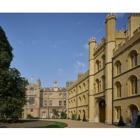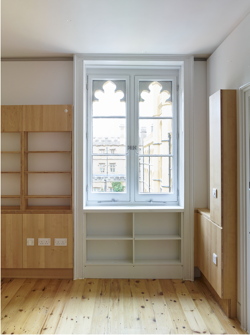Gothic revival

The energy-efficient upgrade of a Grade I-listed 200-year-old hall of residence at the University of Cambridge sets a new standard for the energy efficient upgrade of the UK’s historic buildings, as Hywel Davies of CIBSE explains.
If the UK is to meet tough carbon-reduction targets for 2050, it will have to tackle the emissions from the country’s 10 000 Grade I-listed buildings. These buildings are notoriously difficult to refurbish because changes require listed-building consent and because the interventions are required to be reversible to allow the building to be returned to its pre-intervention state. The refurbishment needs to understand the original design principles to ensure that the work enhances the building and does not cause longer-term effects — for example by installing heating and changing the moisture balance in the fabric.
Speaking at the recent CIBSE Building Performance Conference, architect Oliver Smith, a director of 5th Studio, and Joel Gustafsson, senior engineer at Max Fordham, explained how they tackled one of the most radical refurbishments ever attempted with the retrofit of New Court, part of Trinity College, Cambridge. This scheme shows that with the right approach, a willing client and an imaginative partnership of engineer and architect a radical low energy refurbishment of a Grade I-listed building is possible.
The New Court is a neo-Gothic courtyard of 4-storey buildings that have accommodated students, including the current Prince of Wales, for almost 200 years. The conservation-as-normal approach would have been to do very little with this notoriously draughty building because its listing sets out to maintain the integrity of the building’s fabric. For New Court, the team set out to enhance the building’s fabric to reduce heat losses by adding insulation and improving its airtightness.
Adding insulation to the listed exterior was not an option, so the team set about developing a means of insulating the walls internally. Aside from the need to obtain consent for the intervention, the team’s biggest concern with this approach was that improving the wall’s thermal insulation could lead to moisture and condensation problems causing mould growth and the rotting of the building’s timber joists, wall plates and grounds.
Using the hygrothermal modelling tool WUFI, Max Fordham evaluated a series of interventions with various insulation thickness and vapour-barrier locations. With new-build schemes, the vapour barrier is usually on the inner face of the wall, to prevent vapour entering from inside. However, for New Court the modelling showed that solar-driven moisture pressure would drive moisture into the wall from the outside, through the brick, stone and render walls where it would collect on the cold face of the insulation. To prevent this occurrence the team chose to leave out the vapour barrier to allow vapour to pass through the wall.
This approach restricted the amount of insulation that could be added because the wall had to remain warm enough to prevent interstitial condensation. The optimum thickness of insulation is dependent on the properties of the natural materials used to construct the wall, so samples of each material were sent to a laboratory for analysis, with the results used to inform the WUFI model of the wall.
At the same time as the samples were being analysed, the team also used monitoring experts ArchiMetrics to monitor the performance of the actual building. This involved measuring conditions internally and at various points within the wall. ArchiMetrics also installed a weather station to measure external conditions. The weather station enabled the WUFI model to be calibrated and its performance predictions to be checked against the walls’ against the actual performance figures.
Based on the model, this insulation solution was selected.
• 4 mm of lime plaster to level the wall’s inner face;
• A 72 mm-thick sheet of wood-fibre insulation.

• An inner face of plasterboard.
In addition to insulating the walls the team also had to minimise heat losses and air leakage through the building’s wooden casement and sash windows. Over 30 options were modelled, including replacing the windows with double- and triple-glazed units. Although the existing windows were not original, English Heritage would not permit their replacement with new units, so the old frames were removed and refurbished. This involved replacing the existing glazing with slim, vacuum double-glazed units and adding draught proofing.
An MVHR (mechanical ventilation with heat-recovery) system prevents moisture build-up in the rooms. The MVHR units are hidden in the roof void. Supply air is ducted from the units down the old chimney flues and into the rooms through the fireplaces. Air is extracted via the ensuite WC or allowed to spill into the communal areas via an undercut to the room door, before it is extracted from the communal kitchen.
When the team applied for listed-building consent with this solution, the local council used BRE to appraise the team’s work. The research organisation concluded that the exercise was robust, but decided that there was still the possibility moisture problems might occur. As a consequence, listed building-consent was only granted on the basis that the college undertake to monitor and report on moisture levels within the fabric for seven years. Should problems be discovered, and be shown to result from the insulation, then a number of mitigating actions can be taken and, as a last resort, the insulation removed.
The refurbishment also involved the installation of new services, including new heating. A radiator heating system installed in the 1950s was removed and replaced by a low-temperature underfloor heating system. Initially this is fed from an existing plantroom; in the future heat will be supplied from a ground-source heat pump. A control system incorporating an occupancy sensor controls the heating and lowers the set temperature after four hours without an occupant; the set temperature is lowered further after the room has remained empty for 24 hours. Additionally, sensors located in the window frame turn down the heating when the windows are open.
The new lighting and room electrics are incorporated into a series of lining panels attached to the wall. Because these are interventions on a Grade I-listed building they are designed to be fully removable, the lining panels incorporate lighting and electrics and eliminate the need to chase wires into the wall.
Initial results show the building to be performing as expected, which should ensure the students are comfortable for another 200 years. More importantly, the solution devised by 5th Studio and Max Fordham shows that it is possible to make radical energy improvements to the thousands of other Grade I-listed buildings and provides some practical examples of what can be done to inform those responsible for listed building consents.
Hywel Davies is technical director of CIBSE.








